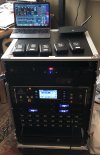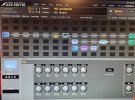Hmmm, while I love Joe B, it's certainly rather easy to get a great guitar and ensemble mix in IEM's, even in mono, and even with inexpensive IEM's as long as you have perfectly fitted memory foam tips. Also importantly, a proper ambience that provides some early reflections that your brain expects to hear in normal playing environments is required, like when you're off-set to your cab (or your cabs are behind plexiglass like Joe's...), and of course a decent tone to begin with.
The advantages of controlled stage sound sans directional/beamy guitar cabs killing a few seats, and/or blasting wedges off the back wall arriving out of phase while overpowering FOH, plus a perfectly consistent mix in all venues is a God send to modern concert production, and modern stage monitoring.
The advantages of controlled stage sound sans directional/beamy guitar cabs killing a few seats, and/or blasting wedges off the back wall arriving out of phase while overpowering FOH, plus a perfectly consistent mix in all venues is a God send to modern concert production, and modern stage monitoring.
Last edited:


